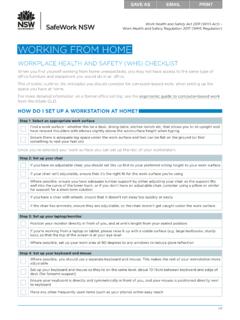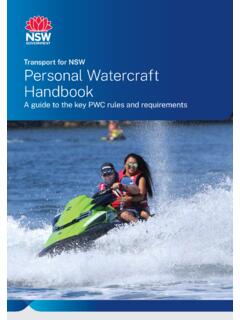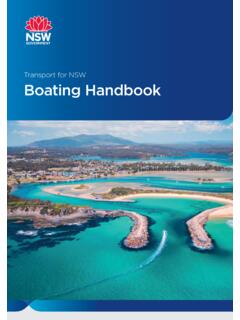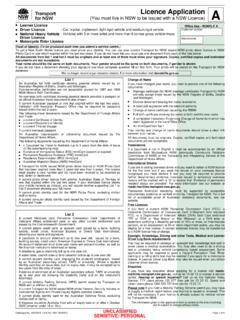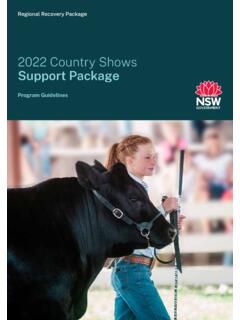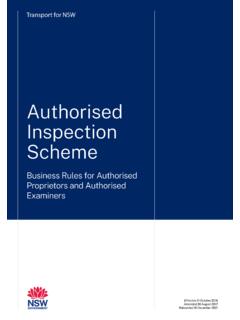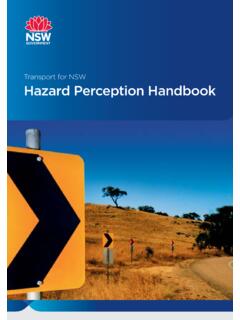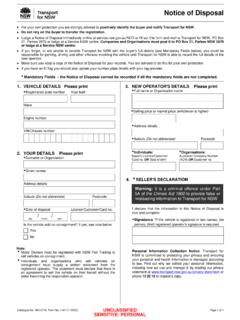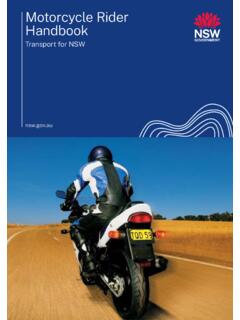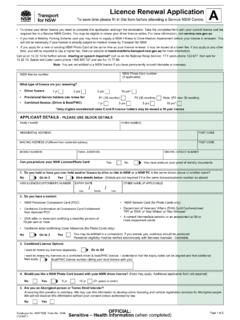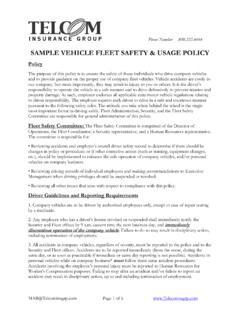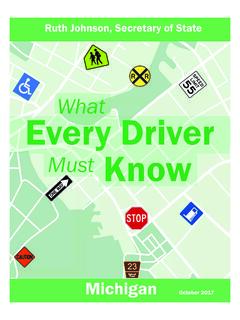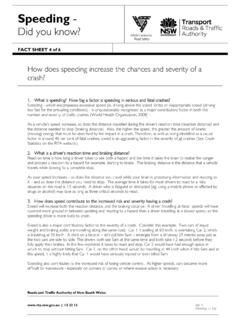Transcription of Vehicle Standards Information - Transport for NSW
1 Transport for NSW. Vehicle Standards Information | 1 April 1998 28. Guidelines for modifications to motorcycles Introduction The following guidelines have been prepared to explain the various requirements you must meet if you alter your motor cycle from its original specifications. Obviously, the alterations must not affect the safe handling of the motor cycle or endanger either the rider or any other road -user. You must not alter your machine in any way such that it will create a nuisance either to other road -users or to any member of the public. Contents Handlebars Wheel and Tyres Noise Nuisance Mudguards Foot and Hand controls Chain Guards Frame or Suspension Modifications Other Requirements Handlebars Handlebar dimensions have to be limited to ensure that you have adequate control over your motor cycle at all times: On motorcycles manufactured before 1 July 1988 ( ): a) The handlebar must have the same shape and be of same length on either side of the front wheel and steering head assembly.
2 B) The distance between the extreme ends of the handlebar (V) must not be less than 550mm. c) The highest point on the handle bar must not be more than 380mm (W) above the top of steering yoke. d) Where the highest point of the handle bar is more than 205mm vertically above the top of steering yoke (W), the distance between the extreme ends of the handle bar (V) must not be less than 660mm. Figure 1. Motorcycles manufactured before 30 June 1988. , issued 1 April 1998 Page 1 of 5. On motorcycles manufactured after 30 June 1988 ( ): a) The handlebar must have the same shape and be of same length on either side of the front wheel and steering head assembly. b) The distance between the extreme ends of the handle bar (X) must not be less than 500mm and not more than 900mm. c) The height of the lowest part of the handgrip must not be more than 380mm above the lowest part of the upper surface of the rider's seat (Y).
3 D) The horizontal distance between midpoint of the steering yoke bearing and a point vertically above the centre of the front wheel must not exceed 550mm. Figure 2. Motorcycles manufactured after 30 June 1988. Wheels and tyres On all wheels (including any side-car wheel), the tyre size must be suitable for the rim. Each tyre and rim must be strong enough to support the machine when it is fully loaded. Most major motor cycle tyre specialists can tell you the right tyre and rim for your machine and the appropriate tyre speed rating. Noise nuisance Motor cycles manufactured from 1st July, 1975, are subject to strict design requirements for noise limitation. In this case, components affecting noise emission (especially exhaust systems). must not be modified and must be maintained in a serviceable condition.
4 Any replacement component must be as near as practicable to the original component specification. If you modify or replace an exhaust system on a pre-1975 motor cycle, you must remember that the law prohibits all motor vehicles from causing excessive noise due to the condition or construction of the Vehicle , or the manner in which it is operated. Do not replace or alter the exhaust system if this is likely to increase its noise output beyond that of the unmodified system when in good condition. , issued 1 April 1998 Page 2 of 5. Motorcycles manufactured from 1st July 1988 have all components of the Silencing System marked with the name or trade name of the manufacturer. Every motorcycle carries Information of the Stationary Noise Test in the following format: Any replacement part of the exhaust system must show the trademark or the name of the original manufacturer of the system.
5 Mudguards Mudguards must be fitted to all wheels (including side-car wheels). Each mudguard must be at least as wide, over its entire length, as its respective tyre. A front wheel mudguard must cover the rearward section of the wheel through the area between two lines, one vertical and the other horizontal, both drawn through the centre of the wheel. If suitable protection is afforded by the frame or other construction of the motor cycle, the front mudguard needonly cover the area that is unprotected. Figure 3. Mudguard dimensions A rear wheel or side-car wheel mudguard must extend at least from a point vertically above the front of the tyre to a point vertically above the rear of the tyre. It must be mounted as close as practicable to the tyre. Foot and hand controls The controls for motor cycles are standardised, therefore the position and operation of foot and hand controls must be kept, as far as practicable, to the manufacturer's original specification.
6 For example, if you move the rider's footrests rearwards (that is, convert to rear sets ) it is not permissible to reverse or invert the gear lever. For safety reasons, the only acceptable method for this conversion is to fit a linkage which keeps the gearchange pattern the same as the original. You should always be able to operate the brake pedal without lifting your foot from the footrest. , issued 1 April 1998 Page 3 of 5. Chain guards If your motor cycle is chain-driven and the construction of the frame is not sufficient to protect you and/or your pillion passenger from the driving sprocket and the upper run of the chain, the machine must be fitted with a chain guard. The guard must extend at least 300mm rearward of the rearmost footrest or to the vertical centre of the rear sprocket.
7 Figure 4. Chain guard dimensions Frame or suspension modifications Motor cycle design is a complex task. Before you modify your motor cycle's frame or suspension, you should be aware that structural changes to the frame, steering head, front forks, suspension, brakes or wheels may load vital components well beyond the limits for which they were originally designed; this will increase the probability of failure and will be a danger to the rider and to other road -users. TfNSW will register a modified motor cycle with a properly designed custom frame, extended forks and structural modifications but only if submitted with a report from a recognised engineering signatory, detailing the changes and showing that the changes have not made the cycle unsafe. It is recommended that you seek the advice of a VSCCS Licenced Certifier before the modification is commenced.
8 See TfNSW VSCCS Bulletin 1. Other requirements a) If your motor cycle is fitted with a sissy bar, it must not extend above the rider's head and should not have any sharp points or edges. b) Motor cycles with no rear suspension (that is, hard tail ) must have a sprung seat for the rider and, where a pillion seat is fitted, it must be sprung too. c) Your motor cycle must be fitted with two braking systems; one capable of acting directly on the front wheel and the other on the rear wheel. If a failure occurs in one of the braking systems, then the other system must be operable. d) If a side-car or side-box is attached to your motor cycle that was manufactured on or after 1. March 1976, a mechanical parking brake must be fitted. Recording changes If a motor cycle modification affects any of the details shown on the registration certificate (engine number, engine capacity or the addition of a side-car or side-box), the law requires that you give notification of such alteration and forward such certificate to the TfNSW for adjustment.
9 A word of advice check with your insurance company before making any changes to your motorcycle as some modifications might make your insurance cover void. , issued 1 April 1998 Page 4 of 5. Further Information NSW Legislation road Transport ( Vehicle Registration) Regulation 2017. Service NSW (SNSW). To register a Vehicle , apply for a permit and to apply for a driver or rider license To locate your nearest SNSW office | T 13 7 7 8 8. Transport for NSW. For Information & advice related to Vehicle registration, permits & driver/rider licenses | T 13 22 13. TfNSW Technical Enquiries For Information & advice related to Vehicle construction, modification and registration requirements in NSW. PO Box 1120, Parramatta NSW 2124. E | T 1300 137 302 | F (02) 8837 0037. TfNSW Vehicle Safety Compliance Certification Scheme (VSCCS).
10 For Information & advice related to VSCCS Licensed Certifiers. VSCCS | E | T 1300 336 206. Department of Infrastructure, Transport , Regional Development and Communications For Information related to building or importing road vehicles for use in road Transport within Australia; also for Information on & to access Australian Design Rules (ADRs) & associated Circulars; Vehicle Standards Bulletins (VSBs). GPO Box 594 Canberra ACT 2601. | T 1800 815 272 | F (02) 6274 6013. National Heavy Vehicle Regulator For Information & advice related to the construction and modification of heavy vehicles (ie those with a GVM or ATM exceeding ); requirements for heavy Vehicle permits &. exemptions. PO Box 492, Fortitude Valley Q 4006. | E | T 1300 696 487 | F (07) 3309 8777. , issued 1 April 1998 Page 5 of 5.
